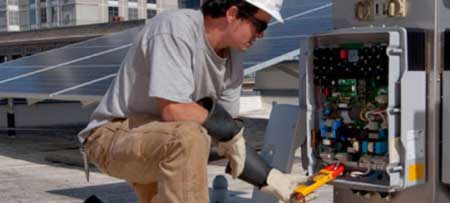Operations and maintenance (O&M) is a growing market within solar. In the early years of the industry, O&M was looked at in basic terms as fixing a broken inverter or cleaning panels—ensuring the project is operating and is maintained. As solar installations have taken off, so too has the need for preventative maintenance to guarantee systems are working to their potential.
“People have not looked at O&M deeply enough in their fleets, and they really need to think about what that means over 20 years,” said Marty Rogers, vice president of global service and support for Enphase Energy, which recently bought O&M provider Next Phase Solar. “If we manage the solar asset and keep them performing and as fresh as possible, there is an overall savings for the financial institute. By doing the proper preventative maintenance and O&M, you keep that asset fresh and you keep the financial institutes happy with their asset performance.”
O&M includes everything from preventative maintenance tasks (like module cleaning or thermal scans of inverters) to proactive services (like system monitoring and enhanced reporting).
“Effective O&M is more than just tactical duties, such as following a maintenance manual, module cleaning or ground maintenance,” said Don Buck, director of global service business development and service sales for the Americas for SMA America, an inverter manufacturer and full-service O&M provider. “O&M must also mitigate risk factors by proactively identifying potential issues and addressing them before they can impact an owner’s bottom line.”
O&M is important across all PV applications because it protects power production and maximizes ROI. With proper O&M, residential customers experience greater power output and a reduction of energy bills, commercial customers benefit from less system downtime essential to day-to-day operations and utility-scale customers ensure long-term viability and profitability.
Installers and system owners are starting to look at O&M services more proactively. Instead of just working with the “break-fix” model (replacing a panel that’s cracked or an inverter that isn’t working), preventative maintenance is making its way into packages. In order to have the most efficient system, Rogers said it’s important now more than ever to separate the installer from the O&M provider.
“As people are really gearing up to install more solar, installation crews are focused on being efficient at installation, so it’s an opportunity for the O&M piece to be very efficient with O&M,” he said. “In the past, installation crews would go off to do maintenance on a system, but it would take them away from being efficient on [installing] new systems. We have a large [O&M] fleet around the country, and they can go manage those systems in an efficient way, because they’re not trying to do something else in between.”
This post-installation expertise is really beneficial to the end customer.
“When we go to a site, we’re very quick at analyzing what the problem is and taking corrective action,” Rogers said. “If it’s someone who doesn’t do that as a day-to-day thing, then they could waste a lot of time trying to figure out the problem.”
When everyone in solar is trying to cut costs and save time, O&M can help.
“Reducing soft costs is as important to PV today as it will be tomorrow,” Buck said. “O&M costs will decrease as processes become more efficient and this market segment achieves economies of scale. O&M is relatively new and it will naturally reduce in cost as it becomes more widespread and technology improves, much like PV devices (such as inverters) have themselves. O&M will continue to be a vital part of the PV landscape because a properly maintained solar system can increase yield up to 30%, accelerating investment payback.”
Published with permission from the original publication on Solar Power World Online By Kelly Pickerel.












Comments